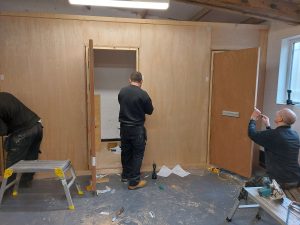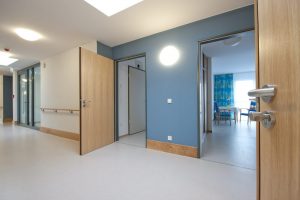Can I certify a fire door? This is a frequently asked question. Since the tragic fire at Grenfell Tower in June 2017, compliant installation of fire doors and fire protection as a whole has been firmly under the spotlight.
Clients having new fire doors installed across all sectors – particularly in premises comprising housing, healthcare and student accommodation, where people sleep and fire safety is particularly onerous – now require that fire door installations are ‘certified’ in some way. This requirement is now much more prevalent than before the Grenfell tragedy; in this article we will examine what it means.

Fire Doors Complete practical fire door installation training assessment session in progress
Certify
In simple terms this word means ‘to confirm in a formal statement’. So if we apply this to new fire doors, the obvious question is ‘confirm what?’
In order to be placed on the market for sale, a fire door must have evidence that it will perform to a prescribed standard in a fire test. That evidence is available in a document and is often referred to as the ‘certification’. So the fire door can be said to be ‘certificated’ and we would purchase those certificated fire doors for installation at a building, whether it be new or existing.
So let’s say we have our certificated fire door and we are going to install it at the entrance of a flat within an apartment block. In order to do this we will need other components such as a door frame, hinges and self-closing device to name a few. What about these other components, do they need to be certificated too? And what about the installation – that needs to be certified doesn’t it? Or do we mean certificated? Read on to find out.
The fire door
When we go to the merchant to buy a fire door, we mean a door leaf that is fire resistance rated. But when we talk about a fire door installed somewhere in a building, we mean a complete fire door assembly or fire door-set with all the necessary components, so that it functions correctly. Let’s call the door from the merchant ‘A’, and we will call the door somewhere in the building ‘B’.
In order to get from A to B, we need to purchase a suitable fire door leaf, the other necessary components, and then install all of them into a pre-prepared opening in a suitably fire resistant wall. The end result, our client has said, needs to be certified. We can only do this when we make sure that the door leaf and all the other associated components are suitable, compatible and installed in accordance with the manufacturers’ installation instructions and product certification data sheet.
So, we must start with a suitable survey that includes taking all the necessary dimensions, noting the configuration of the door (e.g. single leaf, double leaf, single acting or double acting), the door frame type, noting the floor condition to avoid the door bottom edge catching on the floor, noting the type of self-closer required, the type of hinges, as well as the glazing, and so on.
We cannot purchase the door leaf and other components until the survey has been completed; this is because the type and size of the door leaf will be dictated by the findings of our survey, as will the type and size of the door frame and other components that we need. Furthermore, we must consult the data sheet for the door to see which type and size of intumescent seals and hinges, for example, we need. These components, where they are fire rated, will also have fire resistance performance certification.
So to summarise, we need to:
- Carry out a suitable survey.
- Purchase a suitable fire door leaf.
- Consult the data sheet for the door leaf.
- Purchase all the necessary components that are both compatible with the door leaf, and suitable for the end use.
Alternatively, we can purchase a fire door-set that comes with all the necessary components. This saves the task of having to ensure that the other components are compatible with the door leaf because the door-set manufacturer should ensure compatibility. The fire door-set will have a fire resistance performance certification, either as a door-set, or using ‘cascading’ evidence from its relevant components.

Installing the fire door
The installation of the fire door assembly or fire door-set must comply with the British Standard BS 8214: 2016 Timber-based Fire Door Assemblies – Code of Practice. This will mean that we will have to refer to the relevant manufacturers’ data sheets and installation instructions because there are restrictions on trimming the edges of door leaves, requirements for the positioning and fitting of ironmongery, and strict requirements about the intumescent edge seals and smoke seals. There are also the well-known requirements for door to frame gaps and under-door gaps, as well as the not so well-known door, frame and wall alignment requirements.
Only by carrying out the installation fully in accordance with the British Standard and the manufacturers’ instructions and data sheets, can we be sure that the installed fire door is compliant with proper evidence of performance. If it’s not compliant then there is a twofold risk:
1) That the door will fail to provide the required smoke and fire performance in a fire.
2) That the manufacturer’s certification will become invalid.
So it’s easy to see why installers need to be competent to carry out this work, and why clients should require the installer to certify the door.
Back where we started… And adding quality assurance
We began by asking the question ‘Can I certify a Fire Door?’
The answer in simple terms is yes, but only if we carry out the installation in full compliance as described above, and can provide the client with documentary confirmation that we have done this, together with the various certifications for all of the products installed. All of the product data sheets and installation instructions should also be handed over, so that the client may maintain the doors in good working order in the future. Think about this as ‘best practice’, because actually what we would be doing in checking and certifying our installation work is operating a Quality Management System, and of course the installation of any life safety system should be subject to quality control. So as well as providing the client with certification, we are making sure that our work is quality assured, and that is something to take pride in.

Fire door inspections and training courses, UK
Here at Fire Doors Complete Ltd we have a team of experts with many years of relevant experience and accreditations, and as providers of FireQual accredited and NOCN accredited fire door training courses, we can assist installers in learning the essential knowledge about fire door installation, sign-off, certification, inspection, and maintenance, fully up to date with any Building Regulations or recent regulation changes. We can also provide reassurance with a certificated fire door inspection scheme, for the during-installation and post-installation inspection of fire doors, resulting in a comprehensive inspection report with full details about any doors that are non-compliant, and the reasons for such non-compliances.
For more information, please contact us via the contact page, and ask about our Fire Door Installation Checklists that may be used by suitably competent persons, to check that newly installed fire doors are compliant before they are signed-off and handed over. As well as fire door inspection training and fire door maintenance training, from August we will be offering an optional training course on ‘How to sign off and certify fire door installations’.
Frequently Asked Questions
What are the main types of fire door certification available in the UK?
In the UK, the primary types of fire door certification include Certifire, BM TRADA Q-Mark, and the LPCB certification. These certifications ensure that fire doors meet rigorous safety standards and are tested for fire resistance.
How does third-party certification for fire doors work in the UK?
Third-party certification involves an independent assessment body evaluating fire doors against specific standards. This process includes testing, regular inspections, and audits to ensure ongoing compliance with safety regulations.
How often do fire door certifications in the UK need to be renewed or updated?
Fire door certifications typically need to be renewed every five years, but it is essential to conduct regular inspections to ensure that the doors remain compliant with current fire safety standards. For expert guidance on maintaining fire door compliance, reach out to us at robin@firedoorscomplete.com
